Nokia has announced its intention to try and nearly double its shareholding in Symbian by buying Psion shares in the venture, taking them to a 63.3% holding. Symbian, created arguably the most successful rich media Operating System (OS) which is primarily used on mobile phones and portable devices. Almost 2.7m units were shipped with their OS in the first six months of 2003 and it is currently owned by seven partners; Ericsson, Panasonic, Nokia, Psion, Samsung, Siemens and Sony Ericsson.
Nokia propose to pay Psion in two ways; £93.5 million (~$173.8m, ~€137.1m) as a fixed payment, plus £0.84 (~$1.56, ~€1.23) for every Symbian OS equipped phone Nokia sells during 2004 and 2005. Psion are currently estimating the deal will be worth around £135.7m (~$252.1m, ~€198.4m).
This is not the first time there has been a significant shift in the Symbian ownership. Back in August 2003, co-incidentally Symbian’s fifth anniversary, Motorola announced it would exit Symbian, selling its 19% holding. The two partners picking it the holding were Psion who increased its holding from 25.3% to 31.1% and Nokia bought the rest of the Motorola shares, increasing its holding from 19% to 32.2%. Psion paid Motorola £17m (~$31.5m, ~€24.8m) cash, valuing Symbian at that time at £300m (~$557.4m, ~€438.4m). The current Nokia/Psion deal values Symbian at £430m (~$798.9m, ~€628.4m).
At that time David Potter, Chairman of Psion gave hints at their possible exit from Symbian, “Psion will continue to play its role in driving Symbian towards the successful exploitation of its market. At the same time, realising the value of out investment in Symbian for the optimal benefit of Psion shareholders is a key strategic goal”
This leaves two questions hanging in the air. What will happen to Symbian’s other minority shareholders now Nokia is far and away the largest shareholder? Where are Psion going now?
The other owners, lead by Ericsson, the next largest owner (17.5%), may feel shouldered out of Symbian or indeed be uneasy providing income to their largest competitor. Currently the only other option they would have is to go the Microsoft route with their less than perfect offering.
A few years ago Psion got out of the consumer hardware business and they also sold Psion Software to Visto in February for an undisclosed amount. They are now placing their bets on wireless applications in the enterprise. Initially growing Teklogix, which manufactures rugged, wireless devices to help companies streamline their logistics. They also plan to move into providing support to mobile workers in the field, such as medical staff who are visiting patients in their home.
Teklogix is an area they feel they have a strong footing in this business already, making it is a defendable area with potential for great expansion. The CEO, Alistair Crawford says they plan to focus on RFID and Voice. The benefits of RFID in the warehousing business are well known. Psion also feel there is benefits in using voice input there, as the operators quite often need to have both hands free, or their not able to use their hands, for example in a refrigerator unit.
Psion is a company that has changed considerably over its 25 years from its start writing software, in particular Chess for Sinclair computers, through single handedly pioneered the handheld computer market back in the 1980’s., to defending themselves against the onslaught from Microsoft. We’ll watch this space with interest.
Nokia to purchase Psion shareholding in Symbian – Press release
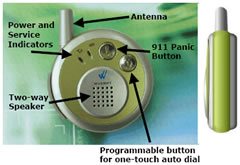 Wherify Wireless, based in Redwood Shores California, have announced what they claim is the smallest device to contain a GPS receiver and CDMA mobile phone. It has been specifically designed to help locate people carrying it. It is very compact (48mm x 12mm), light (45 grams) and simple to use, with only two buttons to operate. One button directly alerts the emergency services, 911, giving them the location within a few feet and ability to have a conversation with owner. The second button carries out the same function but to a user programmable phone number.
Wherify Wireless, based in Redwood Shores California, have announced what they claim is the smallest device to contain a GPS receiver and CDMA mobile phone. It has been specifically designed to help locate people carrying it. It is very compact (48mm x 12mm), light (45 grams) and simple to use, with only two buttons to operate. One button directly alerts the emergency services, 911, giving them the location within a few feet and ability to have a conversation with owner. The second button carries out the same function but to a user programmable phone number.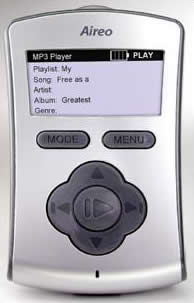 Ever since the rise of the portable digital music player people have been discussing the possibilities of connecting them wirelessly rather than via a cable, either for loading content, or playing it back. After two years development SoniqCast has now released the Element Aireo, the first product to come to market that includes 802.11b (WiFi) support.
Ever since the rise of the portable digital music player people have been discussing the possibilities of connecting them wirelessly rather than via a cable, either for loading content, or playing it back. After two years development SoniqCast has now released the Element Aireo, the first product to come to market that includes 802.11b (WiFi) support.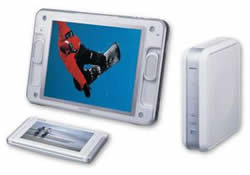 Among the many announcements at CES was an interesting portable 12″ LCD TV screen from Sony, that can be carried around a house and have various content delivered to it from its base station, enabling the showing of video from many different sources, as well as playing music, viewing photos and browsing the Internet. Sony calls it LocationFree™.
Among the many announcements at CES was an interesting portable 12″ LCD TV screen from Sony, that can be carried around a house and have various content delivered to it from its base station, enabling the showing of video from many different sources, as well as playing music, viewing photos and browsing the Internet. Sony calls it LocationFree™.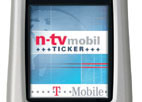 T-Mobile, the worlds second largest mobile phone service provider, has launched a service in Germany enabling their subscribers to watch television over GPRS to their mobile phones. A first for Germany, the service with the very catchy name, “n-tv mobile live TV”, will initial be offering a live stream of news direct to the handsets that have the Real player installed. Currently their Windows-based PDA offerings, T-Mobile MDA or T-Mobile MDA II and Symbian Series 60-based platforms, Nokia 3650, a Nokia 6600 and Nokia 7650 support this.Interestingly there will be no additional charges made on top of the cost of GPRS data transmission, although it should be noted that video is the most dense and bandwidth hungry form of data.This new service follows hard on the heals of a deal between T-Mobile and Kodak that enables their subscribers to send MMS-photographs or other digital photos to be printed at Kodak then deliver via post. To use “Fotoservice”, some software has to be installed on the Symbian-based handset that uploads the images to a private storage area. Given the current low resolutions of phone-based camera, there is an option to place a number of photos on the same 10×15 print.
T-Mobile, the worlds second largest mobile phone service provider, has launched a service in Germany enabling their subscribers to watch television over GPRS to their mobile phones. A first for Germany, the service with the very catchy name, “n-tv mobile live TV”, will initial be offering a live stream of news direct to the handsets that have the Real player installed. Currently their Windows-based PDA offerings, T-Mobile MDA or T-Mobile MDA II and Symbian Series 60-based platforms, Nokia 3650, a Nokia 6600 and Nokia 7650 support this.Interestingly there will be no additional charges made on top of the cost of GPRS data transmission, although it should be noted that video is the most dense and bandwidth hungry form of data.This new service follows hard on the heals of a deal between T-Mobile and Kodak that enables their subscribers to send MMS-photographs or other digital photos to be printed at Kodak then deliver via post. To use “Fotoservice”, some software has to be installed on the Symbian-based handset that uploads the images to a private storage area. Given the current low resolutions of phone-based camera, there is an option to place a number of photos on the same 10×15 print. D-Link have launched the first wireless broadband videophone, which plugs into a television and communicates using either 802.11b (WiFi) or 802.11g, working without the need for a PC. The DVC-1100, otherwise know as the AirPlus i2eye VideoPhone complies to ITU-based H.323 protocol for video streaming and can operate at up to 30 fps.
D-Link have launched the first wireless broadband videophone, which plugs into a television and communicates using either 802.11b (WiFi) or 802.11g, working without the need for a PC. The DVC-1100, otherwise know as the AirPlus i2eye VideoPhone complies to ITU-based H.323 protocol for video streaming and can operate at up to 30 fps.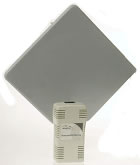 Their new approach is to provide high-speed connections to a central point, then distribute to households that have uninterrupted, line-of-site to the antenna (picture right) mounted on top of the subscribers rooftop. Labelled as P2MP (Point to MultiPoint), it provides a two-way connection that will, in their words, supply connections of a similar speed to 512k ADSL.
Their new approach is to provide high-speed connections to a central point, then distribute to households that have uninterrupted, line-of-site to the antenna (picture right) mounted on top of the subscribers rooftop. Labelled as P2MP (Point to MultiPoint), it provides a two-way connection that will, in their words, supply connections of a similar speed to 512k ADSL.